MARKET OVERVIEW
The Global ATP Testing Device market and its industry together form one of the most important components in the international scenes of diagnostic and sanitation monitoring technologies. ATP testing devices measure biological contamination levels across various sectors. It is critical for any industry that needs rapid and accurate assessments of cleanliness and hygiene, as these devices detect what is referred to as ATP, a molecule found around and within living cells. ATP technologies have wide application areas, including food and beverages, pharmaceuticals, healthcare, and water treatment.
The Global ATP Testing Devices market will take all steps forward with technological advancement and users’ increasing demand toward better hygiene standards. These facilities are embraced for their work efficiency, affording Real-time results that enable industries to take corrective actions. They work by collecting a sample from a surface or, usually, liquid and measuring the light produced through a biochemical reaction involving ATP. Its intensity directly correlates to the level of biological contamination, thus, giving a clear, quantifiable measure of cleanliness.
The most distinctive feature of this market is the range of ATP test devices. Hand-held ATP meters, portable systems, and high-end luminometers serve the different industries, providing varying levels of sensitivity and usability. The devices are generally supplied with specialized swabs and reagents for sample collection and results consistency. The integration into wireless networks, as well as data management systems, will contribute more to the efficiency of the instrument in multi-site monitoring and reporting.
It cuts across many geographies, driven by demand in terms of regulatory requirements and hygiene/contamination control needs. North America and Europe still continue to be significant market geographies due to well-established standards and infrastructures in technology to support it, while the Asia-Pacific market will see rapid growth owing to increasing industrialization and increasing awareness in hygiene practices. ATP testing devices have become relevant internationally because they can be used variously in different environmental and industrial circumstances.
Most likely, innovation will be the guiding trend in the upward trajectory of the Global ATP Testing Device market. Future developments are bound to be defined by some of the emerging trends, including miniaturization of devices and heightened sensitivity, as well as the incorporation of AI-driven analytics. Companies operating in this domain will be focused on investing in research and development to create solutions that are much more efficient while being user-friendly and cost-effective. The development of all rapid, accurate, and easy use testing methodologies will push for further improvements in the designs and performances of such devices.
In essence, the Global ATP Testing Device market will continue to play a significant role in maintaining hygiene and safety standards in the different industries. Such importance is given data on the number of lives affected in public health and the regulations globally regarding the safety of the public. Given the steady development of technology and the global trend toward cleanliness and sanitation, the business will also have an ever-expanding potential, bringing about new opportunities and solutions through innovation in contamination monitoring and control.
Global ATP Testing Device market is estimated to reach $7,564.38 Million by 2032; growing at a CAGR of 8.0% from 2025 to 2032.
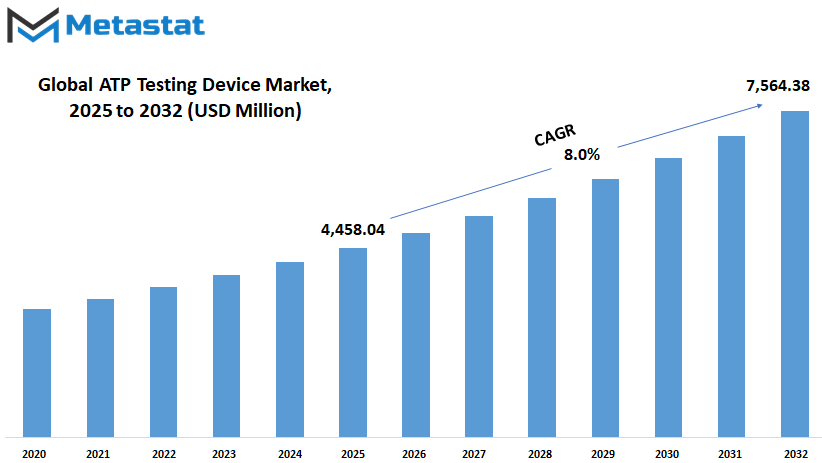
GROWTH FACTORS
The Global ATP Testing Devices market is likely to be one of the most rapidly growing markets in the following years owing to various such factors that explicitly attest to the increasing demand of industries for effective hygiene monitoring and contamination control. ATP testing devices are those devices that are mainly used to measure the cleanliness of surfaces or water by measuring the presence of biological residues through adenosine triphosphate. Because of increasing awareness about health, safety, and quality, the need for these devices is becoming increasingly important in almost all sectors: food and beverage, healthcare, pharmaceuticals, and water treatment. The new stringent goods practices on hygiene maintenance will be an important driver for ATP testing devices.
Another boosting factor in the growth of this market is the increasing trend towards safety and sanitation. Consequently, almost each manufacturing industry has been practicing appropriate hygiene standards so as to avoid contamination and ensure product quality. Contamination is even more serious for food production and healthcare because slight hygiene lapses can endanger human lives. Fast and accurate results are what ATP testing devices offer; this quality strictly favors them as the favorite for hygiene inspection. There will be increased market growth in the coming years because of awareness on these advantages.
Technological advancements are going to play a pivotal role in determining the future of the Global ATP Testing Device market. Manufacturers are also coming up with technology-based devices which can offer better sensitivity, faster results as well as be user-friendly. Portable ATP testing devices, for instance, are finding their way to being popular as they offer advantages; they are also capable of being used on the field. These innovations take the businesses upgraded in monitoring their processes and prompt them to find any related contamination before solving the problem; therefore, ATP testing devices are being put to use in different industries.
Only that the future is bright for positive development, some impending issues could stall progress on the market. One of these is the cost of advanced ATP testing devices, which itself might prohibit a smaller or even a medium-sized enterprise from acquiring it because most of them are often running on extremely limited budgets. Then again, such low awareness and technical know-how in certain regions may restrict the use of such devices. Training programs and provision of cost-effective solutions will be very important for overcoming these challenges and ensuring continued growth in the market.
However, the market has high promise in the opportunities it is set to hold for future growth. The fast-rising demand for testing water quality and environmental monitoring creates a vast potential space into which ATP testing devices could penetrate. As it is getting more common around the world of governments and organizations to tighten regulations regarding water safety and sanitation, there will be an increasing necessity for efficient monitoring tools. This provides a conducive environment for market expansion and opens opportunities for inventing solutions specifically tailored to address these needs.
Coming from strong drivers and good opportunities ahead for the Global ATP Testing Device market, it is expected to grow enormously in its near future. The market is also expected to witness wide adoption and increased demand from multiple industries by introducing current challenges and new technologies.
MARKET SEGMENTATION
By Product Type
There will be continued steady growth of the Global ATP Testing Device Market during the forecast period. The increase will be due to the need for effective hygiene monitoring among various industries. Keeping in mind that cleanliness and safety are essential for business operations, it is likely that the demand for the types of equipment that can instantly and accurately detect contamination will increase. ATP tests play a major role in this because they measure adenosine triphosphate (ATP), which is a molecule in all living cells. Thus, ATP testing is broadly seen as a highly reliable evidence of the presence of organic matter like bacteria, food residues, and other contaminants.
The major reason which has been driving the growth of the Global ATP Testing Device market is the concern related to hygiene and sanitation, especially in sectors like food and beverage, healthcare, and pharmaceuticals. These industries require a sterile environment to preclude an outbreak of a disease and ensure product safety. Stricter regulations and quality control measures are becoming ever more prevalent around the world, so the use of ATP testing devices would naturally increase. These devices are time saving and can provide on-the-spot results so that businesses can take immediate action following the discovery of contamination.
Different types of ATP testing devices have also been designed for specific applications, just like other modern technologies that are being developed. Based on the product type, these devices can be classified as ATP fluorescence detectors, surface swabs, and specifically designed instruments for this particular application. Being extremely accurate and sensitive, ATP fluorescence detectors are best suited for environments where trace contamination can pose a serious potential risk. Surface swabs, however, provide a practical, straightforward solution for the testing of the cleanliness of multiple surfaces, while continuing to emerge other tools in this group due to advances in technology providing further alternatives for industries requiring accurate hygiene monitoring.
The Global ATP Testing Device market is expected to continue seeing constant innovations being made, along with a growing demand for increasingly intelligent and faster processes of testing. In future, ATP testing devices may possibly develop to provide an increased extent of data tracking, remote monitoring, and intricate analysis because digital technology is integrating with automation in hygiene monitoring systems. This will heighten efficiency and sustain better decision-making processes of companies that put a high emphasis on cleanliness.
By Technology
The Growth in the global ATP Testing Device market will, in turn, gain momentum with the growth of technology and growing global health concerns in industrial hygiene and safety. ATP (Adenosine Triphosphate) testing devices help measure cleanliness and detect contamination in environments ranging from healthcare facilities to food production and pharmaceuticals. With industries increasingly coming up with stricter sanitation protocols around the world, the demand for these devices is bound to rise. As all of it said, technology plays a significant part in commercializing this market, which probably keeps modifying the ATP detection methods in offering efficient and more accurate results.
Bio-luminescence is one of the most popularly used technologies in this market. The basis of the principle lies in the measurement of the light obtained generated by ATP reacting with the specific enzyme. Since ATP exists in all living cells, light indicates biological contamination. Speed and sensitivity characterize bio-luminescence-based devices and help the companies in a timely decision regarding the cleanliness performance. However, with the increasing automation, bioluminescence technology will likely become more sophisticated in the future times with real-time data integration and intelligent reporting capabilities.
These two are the most significant technologies under the Global ATP Testing Device markets. This has to do with how much light is reflected or emitted by the substance after it has been subjected to a certain wavelength. Related to this is the development of highly sensitive and accurate ATP testings involving the measurement of fluorescence, which works wonders in situations where precision is considered critical. More importantly, there would be advances in the manufacture of more compact and portable devices, which use this technology and afford spot testing but still deliver reliable results, probably in the future. Then, as expected, some advancements would be available to meet the current increase in demand from industries pursuing a faster, more effective way of ensuring safety standards.
Chemiluminescence is another important technology in the ATP testing market. This method finds out the light emitted from a chemical reaction with ATP, which proves to have excellent sensitivity. It becomes especially useful in locations where any sort of contamination traces must be determined. With technological advancements, chemiluminescence devices may be made more user-friendly and easy to afford, complemented with better digital features and cloud-based data management systems.
From this point forward, the Global ATP Testing Device market will most likely continue to bring about innovation and expansion. With improved public awareness for sanitation and demand for real-time monitoring, this market will realize better prospects in the future. ATP testing devices will adapt to the different needs of various industries worldwide, keeping in line with fast-paced changes in technology. In the long run, this will help maintain safer environments and higher quality within the sectors, which undoubtedly guarantees the future importance of the market.
By Application
In recent years, hygiene and safety awareness is poised to increase their prominence in so many sectors that they consequently will drive market growth in the Global ATP Testing Device with great significance. ATP testing devices detect biological contamination chemically; they measure cleanliness_on surfaces, in water, and in food. As industries increasingly prioritize safety and quality requirements, there will be a rise in demand for these devices. In their effort to assure a cleaner and safer environment, businesses and organizations in several sectors are now aware of the key role that efficient testing methods play, thus making ATP testing devices a must-have tool.
Surface cleaning monitoring is among the key applications for ATP testing devices. This sector will grow continuously due to prioritizing hygienic conditions in sectors like healthcare, hospitality, and manufacturing. ATP testing devices are indispensable to maintaining sterile environments to stop infections in hospitals. Cleaning of preparation and packaging areas is also controlled by the food industry. As consumer expectations rise in terms of safety, advancement in testing methods will be adopted by companies to prove that their facilities are clean under rigorous hygiene measures.
The primary application driving the expansion of the Global ATP Testing Device market is a food safety testing. Parallel to the rising demand for fresh and safe food, manufacturers and suppliers will invest in accepted technologies for testing. ATP testing devices help in the quick detection of contamination that causes foodborne illnesses. The tightening of food safety regulations by governments and other regulatory bodies will compel businesses to comply using effective monitoring tools. The demand for safety and quality will stimulate the development of ATP testing devices that will be increasingly accurate and user-friendly, thereby becoming a benchmark in the food industry.
Water quality testing also has a positive impact on growth. Potable water is critical both for domestic and industrial uses, and ATP testing devices have become a fast and effective means of microbial detection. Concerns about pollution of drinking water and sustainable management of water will lead to increase the significance of these devices. Industries like pharmaceuticals, beverages, and utilities will use ATP test kits to ensure that their water sources comply with safety standards.
In addition to these main applications, various industries would use ATP testing devices for some specific needs. Laboratories, educational establishments, and environmental agencies will use them because of having swift and accurate results. Advancements in technology will likely facilitate ATP testing devices becoming portable, efficient, and accessible, winning them more users across a wider range of industries.
By End-User
The Global ATP Testing Devices Market will witness noteworthy growth in the years ahead, as the world sees an increasing awareness of hygiene and safety in various industries. ATP testing devices measure cleanliness by indicating organic material and are quintessential where sanitation is a must. As with the ever-growing number of industries that require health and safety codes, the demand for these devices is set to increase.
ATP testing devices greatly complement a key area in food safety and quality. Hygiene in food production and handling is extremely important to keep products safe from contamination for the sake of consumers’ health. This increasing number of stringent regulations regarding food safety will lead more companies to invest in ATP testing devices to comply with the standards. Furthermore, as packaged and ready-to-eat foods become more and more popular, the demand for cleanliness will further heighten the need for ATP testing devices.
The ATP testing devices are deployed for maintaining sterile environments in hospitals, clinics, and laboratories. Cleanliness in these facilities is necessary to prevent the infection from spreading and for the safety of patients. Change is a norm in the healthcare system, and with the advancement toward judicious patient care, the importance of infection control will accentuate. Thus, ATP testing devices will be more widely used to assess hygiene levels and uphold higher standards of cleanliness.
They hold great potential in health detection. Monitoring hygiene with ATP testing devices can contribute to healthier surroundings in public venues such as gyms, schools, and offices. Especially in these days of global awareness of cleanliness issues from pandemic experiences, the instances of adoption of ATP testing devices in day-to-day life will reportedly rise. Hygiene has now become a priority for firms and institutions to safeguard their employees, students, and visitors.
Water treatment and the pharmaceutical industry also make use of ATP testing devices. In water treatment, it is important to monitor microbial contamination to provide clean and safe water. The pharmaceutical industry works under high cleanliness standards for the quality of production. Following the growth and evolution of these industries, the demand for efficient hygiene-monitoring tools will continue to grow.
As we see it, technological improvements will enhance ATP testing devices well into the future. Further developments in wireless connectivity and real-time data analysis will make them more appealing to the user and proficient in terms of application. With a strengthening trend toward hygiene and safety in various industries worldwide, the Global ATP Testing Device market will continue to experience rising growth, which would dictate the future of cleanliness and quality assurance across multiple sectors.
|
Forecast Period |
2025-2032 |
|
Market Size in 2025 |
$4,458.04 million |
|
Market Size by 2032 |
$7,564.38 Million |
|
Growth Rate from 2025 to 2032 |
8.0% |
|
Base Year |
2024 |
|
Regions Covered |
North America, Europe, Asia-Pacific, South America, Middle East & Africa |
REGIONAL ANALYSIS
The Global ATP Testing Device market, as predicted in the coming years, will witness a substantial upward thrust owing to technological advancements and growing awareness toward sanitation and hygiene across various industries. With the world becoming more adamant about cleanliness these days, the demand for good testing devices will emerge. ATP (adenosine triphosphate) testing devices, by providing rapid and accurate detection of biological residues, play an important role in ensuring that environments remain free from harmful contamination. As the demand for hygiene monitoring surges, the market will grow with a variety of contributions from different regions.
North America is seen as a stronghold of this market, wherein countries like the U.S., Canada, and Mexico invest substantially in healthcare, food safety, and pharmaceuticals. The U.S. should spearhead the movement from here due to an established healthcare infrastructure and strict hygiene regulations. Increased focus that aims to prevent hospital-acquired infections and enforce safety standards at food production facilities will drive the demand for ATP testing devices in this region.
Europe will witness steady growth, from the sanitary prime interests of the UK, Germany, and France to those of Italy and the rest of Europe. The expansion of food safety and public health regulations adopted with advanced monitoring technologies will mark the way for market growth. With the regional focus on keeping the pharmaceutical and healthcare facilities to high standards, the demand for dependable ATP test solutions will find further accent.
Rapid growth for the Asia-Pacific will come from more traditional factors, among them growing industrialization and awareness of hygiene in the likes of India, China, Japan, and South Korea. As the healthcare systems and food production of these nations are being modernized, the adoption of advanced sanitation monitoring tools will soon become a necessity. At play also will be China and India, formed by greater populations and expanding industries, which will contribute toward a market environment.
Countries like Brazil and Argentina are gradually adopting ATP testing devices, driven by the need to improve healthcare services and food safety standards. Regulatory frameworks to strengthen supplies will thereby see more widespread use of these devices in this region as awareness about hygiene increases.
In the Middle East and Africa, countries like the GCC nations, Egypt, and South Africa shall also contribute to the market development, addressing improvements to public health and safety. As investments in healthcare infrastructure and food production increase, this will also drive the demand for effective hygiene monitoring tools.
With the growing demand for sanitation and sophisticated monitoring solutions, the overall Global ATP Testing Device market is poised for dynamic growth across regions. Each region's individual challenges and developments shall define the future of this ever-growing industry.
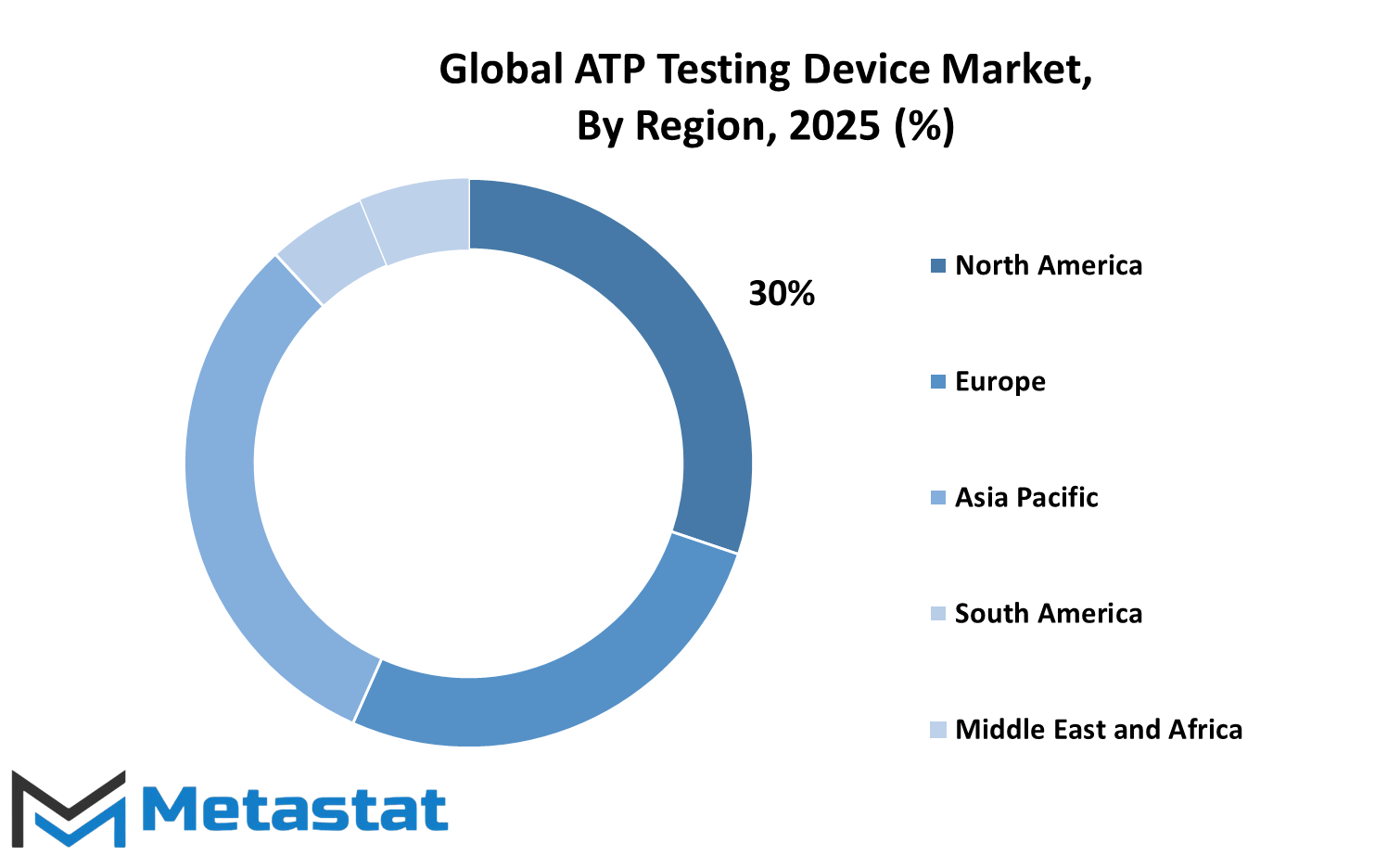
COMPETITIVE PLAYERS
The significant growth uptrend for the Global ATP Testing Devices market in coming years will be induced by advancements in technology with a constant influx of awareness towards hygiene and sanitation in divergent sectors. ATP Testing Devices are used much in the monitoring of cleanliness since they detect organic matter and microorganisms on surfaces as well as in liquids, therefore being indispensable in the food and beverage, pharmaceutical, healthcare, and water treatment industries, in which hygiene is not merely a requirement but a priority. Hence with an increase in demand for rapid hygiene monitoring and accurate tests, ATP testing devices will be much in demand, thereby shaping the future of this market.
The competitive dynamics of the Global ATP Testing Device market are populated with many larger and well-established players who are constantly innovating and developing products to retain their market share. For example, major frontiers such as Hygiena, 3M, and Charm Sciences have built their reputation on reliable and excellent products with strong global distribution channels. They continue to pour money into research and development to refine ATP testing devices in terms of flexibility, speed, and ease of use in response to their customers' evolving needs.
Other than industry leaders, specialized products aimed at diverse applications from companies such as Merck Millipore, Ruhof Corporation, and Kikkoman Biochemifa strengthen the growth of this segment. These players focus mainly on product portfolio expansion, aiming to improve the sensitivity and efficiency of their devices. Biotechnology innovations and digital integration would greatly affect the ATP testing future, spearheaded by companies like LuminUltra Technologies and Creative Diagnostics, which are integrating advanced analytics and real-time data capabilities in their systems.
Yet, smaller players, including Pharmacal Research Laboratories, Inc., Hach Company, and NEMIS Technologies AG, impact the ATP test market by providing niche solutions and a deep focus on focusing on customer requirements. These smaller companies often provide fresh ideas and technical innovation, serving to differentiate the market and provide the user community with a range of options. Along with early players introducing cost-effective solutions targeting markets with great potential are Mediwish Co., Ltd and PCE Instruments India Private Ltd.
With more stringent hygiene and safety standards imposed globally, the need for advanced ATP testing devices will only grow. Market contenders will continue to innovate their products, which will satisfy the current demands while being able to anticipate and proactively address future challenges. The pursuit of improvement and channelization of expansion will thus create ample opportunities for significant growth and transformation of the Global ATP Testing Device market in the anticipated timeframe.
ATP Testing Device Market Key Segments:
By Product Type
- ATP Fluorescence Detector
- Surface Swabs
- Others
By Technology
- Bioluminescence
- Fluorescence
- Chemiluminescence
By Application
- Surface Cleaning Monitoring
- Food Safety Testing
- Water Quality Testing
- Others
By End-User
- Food and Beverage
- Medicine
- Health detection
- Others
Key Global ATP Testing Device Industry Players
- Hygiena
- 3M
- Charm Sciences
- Merck Millipore
- Ruhof Corporation
- Kikkoman Biochemifa
- LuminUltra Technologies
- Creative Diagnostics
- Pharmacal Research Laboratories, Inc.
- Hach Company
- NEMIS Technologies AG
- Mediwish Co., Ltd
- PCE Instruments India Private Ltd.
WHAT REPORT PROVIDES
- Full in-depth analysis of the parent Industry
- Important changes in market and its dynamics
- Segmentation details of the market
- Former, on-going, and projected market analysis in terms of volume and value
- Assessment of niche industry developments
- Market share analysis
- Key strategies of major players
- Emerging segments and regional growth potential



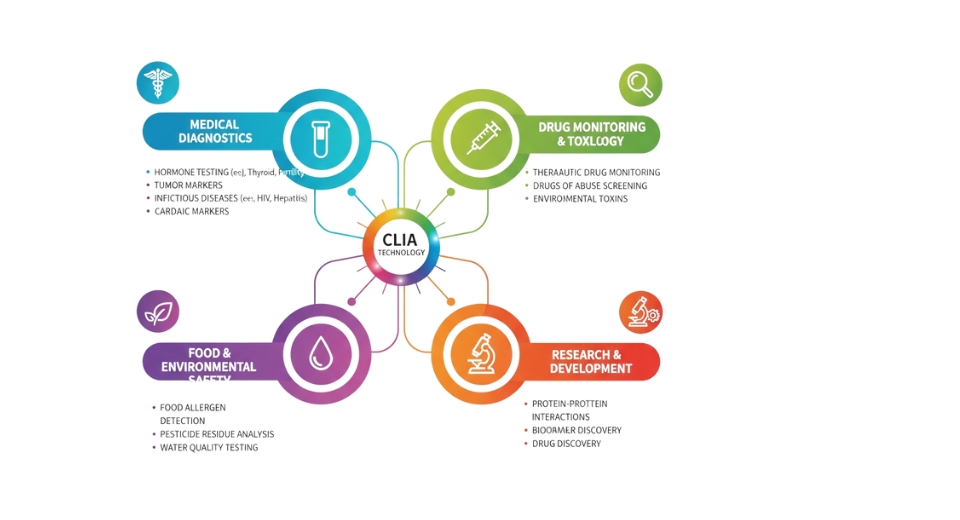

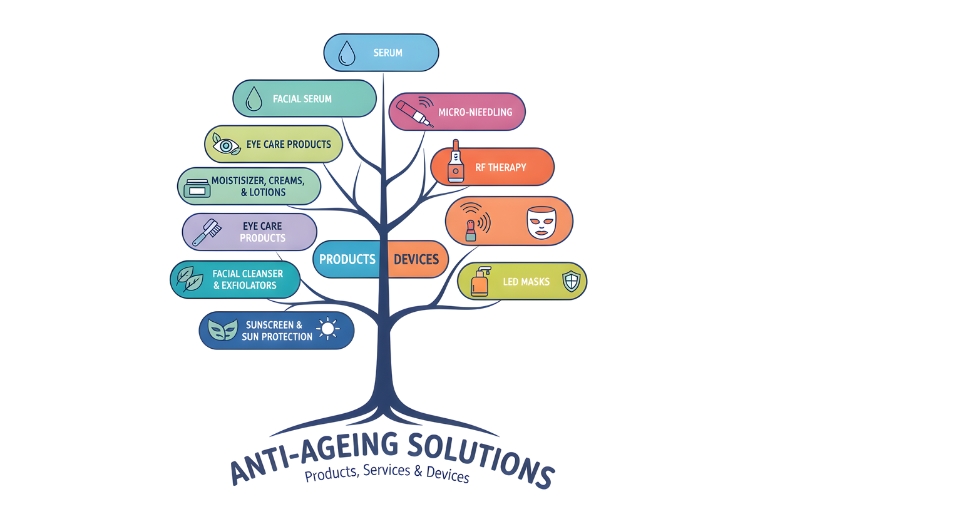
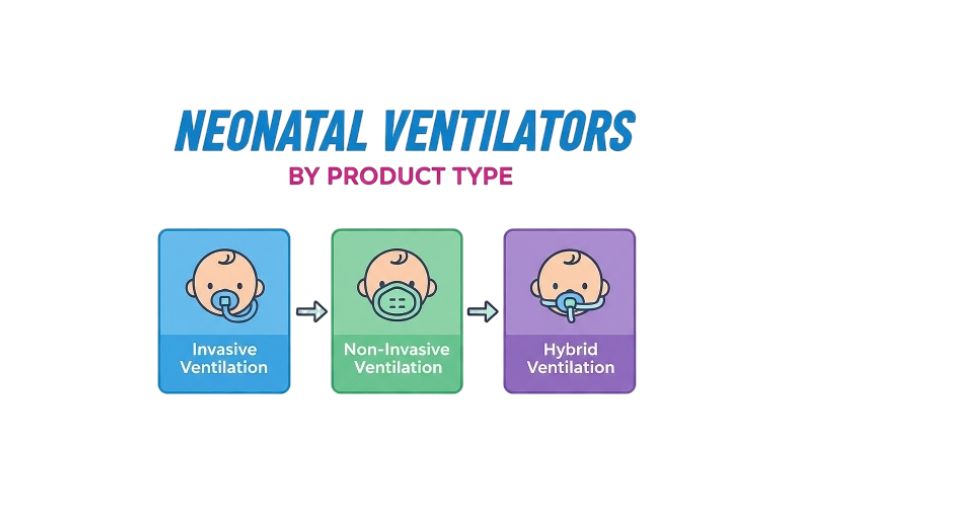

 US: +1 3023308252
US: +1 3023308252






